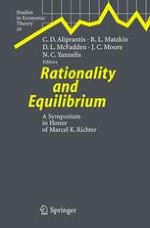2006 | Buch
Rationality and Equilibrium
A Symposium in Honor of Marcel K. Richter
herausgegeben von: Prof. Charalambos D. Aliprantis, Prof. Rosa L. Matzkin, Prof. Daniel L. McFadden, Prof. James C. Moore, Prof. Nicholas C. Yannelis
Verlag: Springer Berlin Heidelberg
Buchreihe : Studies in Economic Theory
